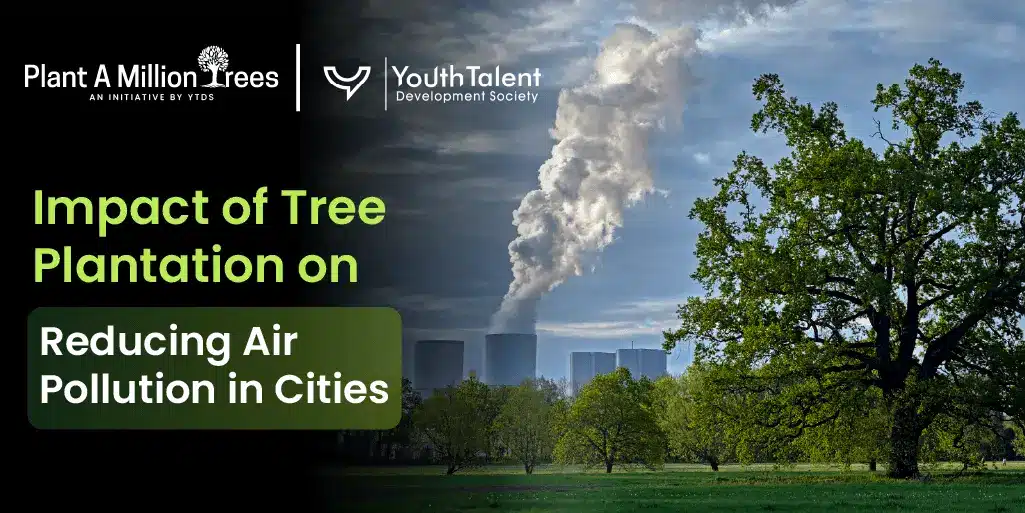Space has also emerged as one of the most prized commodities in modern urban India. Cities are congested with...
Urban air pollution is one of the most immediate environmental health issues of our times. With increasingly crowded city skies and car exhausts on the rise, clean air is no longer a common luxury in large sections of the globe.
Data from the World Health Organization states that over 90% of the world’s urban population is exposed to air that is in excess of healthy pollution levels. India, China, and various African countries cite especially high readings.
In the face of growing worries, natural controls such as tree plantation are becoming strong measures to combat pollution.
Tree planting is more than a cosmetic green—it is an essential part of city survival. Cities need to peer over the horizon beyond concrete and invest in living green barriers.
Trees have a crucial role in absorbing contaminants, moderating temperature, and producing healthier environments.
As Youth Talent Development Society (YTDS) encourages: “Planting trees is not just about the act—it’s about ensuring breathable futures.”
How Trees Help Purify Air

In the realm of gradual air-scrubbing nature, trees silently labor around the clock to purify the air for our respiration. The leaves and bark serve as natural filters to trap dangerous particulates such as PM2.5 or PM10 that are capable of entering lung blood systems.
Trees may be simple plants, but through the beautiful process of photosynthesis, they regulate CO2-the bane of climate change-and release oxygen that humans must breathe.
This is a problem to some economists, but the trees aren’t stopping there. Trees reduce dangerous gases such as NO2, SO2, CO, and O3, which are all pollutants and health hazard sources.
If we are to judge by USDA figures, one single mature tree can lock up as much as 48 pounds of CO2 yearly. On warm days, trees also cause the air to cool down through the process of transpiration, thus alleviating urban temperatures, heat, and smog. To put it simply, trees do more than simply stand tall: They keep us alive!
How Trees Clean Air:
Consider trees to be our green allies in the battle for clean air! Their leaves cling to dust, pollen, and even smoky particles that are floating around like sticky little traps.
Additionally, they have stomata, which are tiny, amazing mouths that actually breathe in the undesirable gases that we do not want.
They also generously exhale the fresh oxygen we require, along with a small amount of cooling moisture, in exchange for ingesting the harmful substances.
Additionally, they help keep things cooler by providing shade, which surprisingly prevents the formation of harmful ozone. Therefore, trees are essentially nature’s amazing, multipurpose air purifiers!
Top Trees That Help Fight Air Pollution
These incredible air-cleaning trees, each with unique abilities:
1. Azadirachta indica, or neem:
This is the champion of tiny particles! Imagine Neem as a super-cleaner that is particularly adept at capturing those tiny, dangerous PM2.5 particles. It also has incredible anti-germ properties!
2. The Nighttime Oxygen Provider or Peepal (Ficus religiosa):
Peepal tree diligently absorbs carbon dioxide, acting as an all-day air purifier. What’s truly unique is that it continues to release new oxygen even after the sun sets!
3. The Filter for Heavy Metals:
Arjuna (Terminalia arjuna) Think of Arjuna as a potent filter that is made especially to capture and eliminate those tough air pollutants, like heavy metals.
4. The Green Pollution Shield– Ashoka (Saraca asoca):
By protecting itself and absorbing pollutants, the Ashoka tree makes the area around it cleaner. It functions as a dense, green wall.
5. Syzygium cumini or Jamun:
The Hero of the Humid Climate! Jamun is your friend if you live somewhere with high humidity! It flourishes in those damp conditions and is very effective at removing particulate matter.
Benefits of Plantation Drives:
Here’s why, explained with a human touch, plantation drives are such a great way to increase the number of trees planted:
Creating Green Breathing Zones:
Plantation drives can be compared to the creation of large, green sponges that absorb pollutants. Wherever we live, work, and play, these “green belts” serve as organic air filters.
Individuals who volunteer for tree plantation initiatives play a vital role in building these natural filters and extending their reach.
Improving Our Health with Cleaner Air:
We are essentially making an investment in our own health when we plant more trees. Our bodies remain healthier and our lungs can breathe more easily when the air is cleaner.
Less Wheezing, Easy Breathing:
Picture fewer asthma episodes, less bronchitis, and simply healthier lungs overall! That’s the power of more trees resulting in cleaner air.
Welcoming Wildlife and a Balanced Nature:
Plantation drives contribute to a richer and more stable natural environment by providing homes and havens for birds, insects, and other creatures in addition to purifying the air for humans.
Case Studies: Cities Where Tree Plantation Improved Air Quality
Seeing how cities all over the world are utilising trees to combat pollution is encouraging! Let’s examine some additional instances, some of which are located in India:
Tokyo, Japan:
The Pioneer of the Vertical Garden and Roadside Air Cleaner! Consider the congested streets of Tokyo, where trees serve as organic vacuum cleaners, removing 20–30% of the dangerously small PM2.5 particles at the point of generation!
Additionally, “vertical forests” and green rooftops are being used creatively to transform buildings into powerful air purifiers!
Delhi Ridge, India:
The Green Lung and Climate Cooler of the City! Consider the Delhi Ridge as the city’s enormous green lung, absorbing carbon dioxide and regulating temperatures.
Near this verdant haven, satellite photos even clearly demonstrate a decrease in dangerous NO2 pollution—nature’s way of saying, “I’ve got this!”
The Hundred Thousand Trees Transformation in London, UK!
In just six years, London made the decision to increase its green cover by planting an incredible 100,000 new trees! The outcome? Neighbourhoods that welcomed these leafy newcomers are seeing a real 13% improvement in air quality, according to air quality sensors.
Kolkata, India: An Incredible Multipurpose Wetland in Nature:
The East Kolkata Wetlands in Kolkata is the superhero swamp! This amazing natural area does more than just handle wastewater; it also serves as a massive air purifier, absorbing pollutants and transforming the city into a beautiful green space.
Talk about finishing two important tasks at once!
Green Planning Makes Chandigarh, India, a City That Breathes Easy:
Chandigarh is a smart city that has foresight! They incorporated numerous green areas and roads with trees into the layout of the city.
The daily efforts of these green spaces to absorb pollutants and trap dust are a major factor in Chandigarh’s consistently cleaner air when compared to other nearby busy cities. It truly demonstrates the impact that a little green thinking can have!
Challenges in Using Tree Plantation for Pollution Control
Here’s a more humane look at the problems with using tree planting alone to reduce pollution:
A Long-Term Commitment:
Tree planting should be viewed as a long-term investment because nature takes time. It takes years for those tiny saplings to get large enough to significantly reduce pollution levels, so it’s not a quick fix.
That’s why it’s equally important to protect newly planted trees during those early years to ensure they survive and thrive. We must be patient!
Choosing the Proper Green Heroes:
It’s not as easy as planting any old tree. The incorrect type of tree can occasionally exacerbate allergies or require more maintenance, which can be inconvenient.
In fact, choosing drought-resistant trees for urban India can help ensure both sustainability and lower upkeep in water-stressed environments. We must make an informed decision!
The Planning Puzzle:
Picture attempting to construct a large project without everyone cooperating. It’s similar to planting trees in urban areas.
Large-scale planting is sometimes made more difficult by poor coordination between city departments and a lack of emphasis on green spaces in urban planning.
Limited Space for Growth:
It can be very difficult to find room for new trees in densely populated cities. There simply isn’t always enough space for the green we require; it’s like trying to fit something large into a tiny box.
Taking Care of the Young:
Young trees require care, just like children do! They may not live, and all of our planting work will be in vain, if we don’t water, prune, and protect them. The key is consistent care.
Tree Plantation and Climate Change: A Combined Battle
Growing trees may be a way to achieve two environmental objectives in a single act! Not only do trees create cleaner air, but they also cool down the planet. This is a more humanly way to explain how trees connect cleaner air and climate action:
Natural City Coolers: Trees act as natural air conditioners that help cool down urban areas. They can actually reduce cooler temperatures by approximately 2 to 4 degrees Celsius, and that can potentially last for hours after the sun has gone down, and help to cool us during those hot urban days.
Energy saving one tree at a time: Trees provide shade to buildings; in turn, trees can be a cooling of buildings, tremendously decreasing the need for air conditioning. Less energy use means less demand on our electric accounts, leading to lower monetary and energy expenditure.
Greenhouse Air Sponges: Trees are massive sponges sucking carbon dioxide out of our atmosphere. Trees are so important because they absorb excessive greenhouse gasses created by cars, factories and other activities that eventually destroy the earth, and furthermore, contribute to slowing down climate change.
Now when we plant trees, we are not just providing a cleaner air system now, but we are building a cooler, more resilient future for ourselves and the earth. It’s literally like having nature’s own defenders in the crusade for our health and future!
How You Can Help Improve Air Quality Through Trees
Everyone can lend a hand in becoming urban greening:
- Participate in Tree Planting Drives: Join up with organizations like Youth Talent Development Society (YTDS) that has community-driven drives.
- Plant a Native Species: Select a local pollution-tolerant tree species or shrub that suits your city’s climate.
- Care for Your Plant: Make sure to consistently water your sapling, put mulch on the base of the tree, and install guards to prevent damage.
- Donate to Green NGOs: Financial donations also assist in extending the plantation zone and maintain the plantation zone.
- Encouraging Green Urban Policies: Increase awareness and support for mandatory tree cover in new building projects, and champion green city plans.
These small acts together make up enormous community movements that can help transform grey cities into green havens.
Conclusion
Tree planting and air pollution are connected! What better way to use a natural, sustainable resource to clean, improve public health, and combat climate change than planting trees in the urban environment? Success depends on careful planning, selecting the correct species, and an ongoing commitment to follow-up care.
For cities positioning themselves for the future, investing in trees is not optional.
As YTDS often states, “Every tree is a promise to breathe better.”
If you contribute through a community initiative, a policy change, or through your own initiatives, we all have the power to clean the air we breathe.
Let’s ‘Plan-Protect-Persist’.




